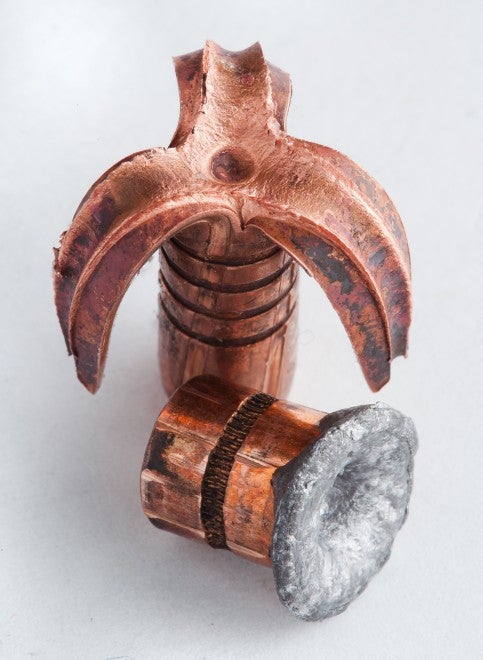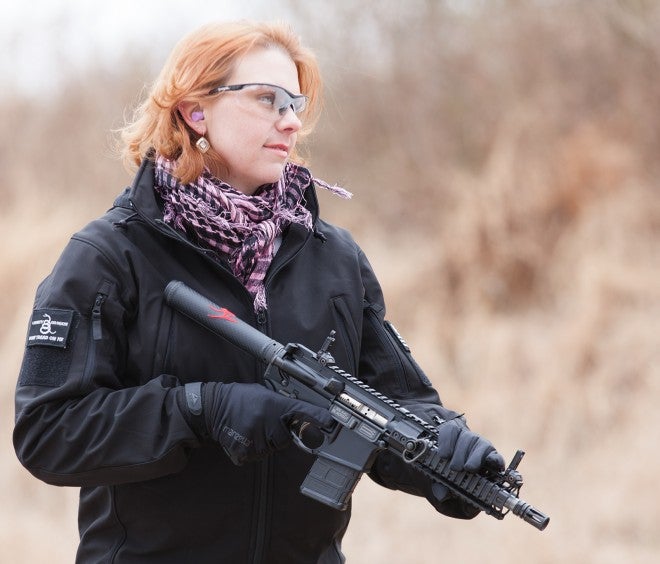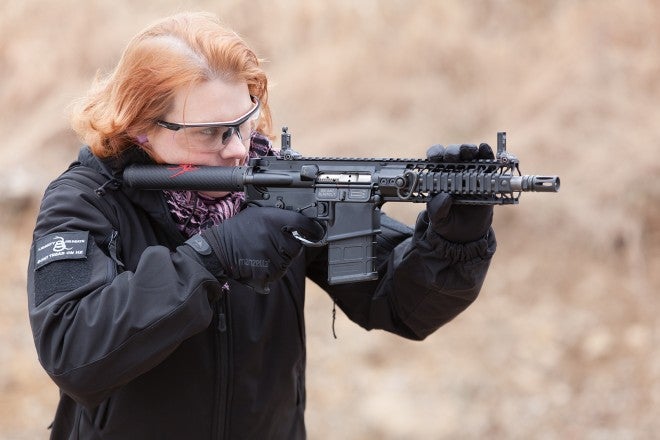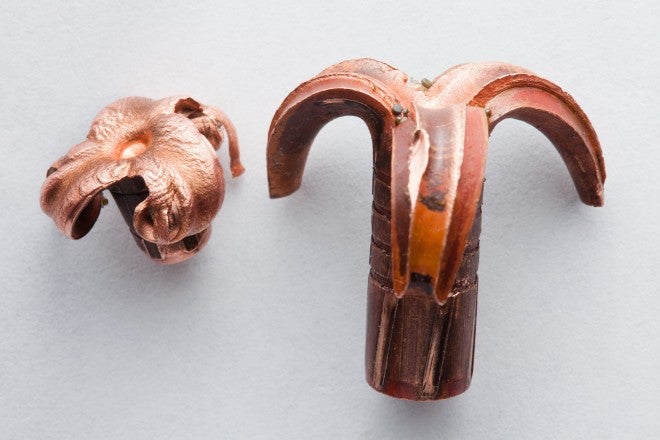Comparative Performance of Three Rifle-Caliber Pistols, Part 2: Spike’s Tactical ST15-LE
Oleg Volk 02.23.15

Table of Contents
- Comparative Performance of Three Rifle-Caliber Pistols, Part 1: PLR16
- Comparative Performance of Three Rifle-Caliber Pistols, Part 2: Spike’s Tactical ST15-LE
- Comparative Performance of Three Rifle-Caliber Pistols, Part 3: Century Arms M92
Spike’s AR pistol addresses the main drawback of .223 pistols: the inefficient internal ballistics. 7.62×35 (300 Blackout) runs well out of 8″ tubes and doesn’t lose as much velocity as .223, throwing a great deal more metal using the same magazine and breech face. The trade-off is the reduced flatness of trajectory and almost doubling of the ammunition weight. ST15 weighs only 5 pounds empty, but a full 30-round magazine adds over pound and a half. Considering the relatively short-range nature of pistols, the increase in bullet weight could be well worth the reduction of longer-range performance.
ST15 is a direct impingement design. Since the round was designed from the ground up to run well with short barrels, it doesn’t suffer from the typical reliability issues of micro ARs. The 8.1″ barrel is enclosed almost entirely with a heavily latticed forend, giving a long iron sight radius and a place for light/laser where the light beam wouldn’t be occluded. The gun comes equipped with a forward QD sling loop but not one in the rear. Unlike PLR16, it’s not designed to be tensioned away from the body for stability: the rear aperture sight cannot be used far away from the eye, so the fabric-wrapped buffer tube has to be used for cheek weld to ensure proper sight picture. Spike’s sights don’t obscure too much of the environment, so both eyes can be kept open when aiming.
The high sight placement allows cantilevered hold on the forend. Since the pistol itself is balanced well enough for support by the right hand only, the left hand keeps the muzzle from rising during rapid fire. Recoil is minimal, so the cheek doesn’t get slapped by the buffer tube. Accuracy is quite good: under one inch at 10 yards from standing and much better than that with an optic from support. Again, the shooter skill is the weak point with most pistols.
A huge variety of ammunition is available in this caliber, with bullet weights ranging from 110 to 220 grains. Most of the plinking ball is in the 110 grain range. Dedicated subsonic loads for suppression are from 180 to 220. My interest in testing was to see if the short pistol could outperform the more traditional 223 AR pistols. The answer is probably yes, judging by the comparison below.
On the left, a supersonic 65gr all-copper G2 Trident in .223 fired from a 12.5″ barrel. On the right, a subsonic 200gr G2 Trident fired from a 9″ barrel. Both had the same penetration depth, about 17.5″, but the 7.62 gun was much quieter and its bullet displaced a great deal more “flesh.” Of course, the smaller, faster round would be easier to use at 200 yards, but hot too many self-defense episodes happen that far out.

In a more oranges-to-oranges comparison, 150gr soft point by HPR clocked in at 1745fps and penetrated 18″ with almost immediate expansion to half-inch. Interestingly, HPR cites lower muzzle velocity out of presumably longer barrel than what I got.
HPR’s 110gr Brenes TSX load clocked in at 2090fps, expanded (judging by the gelatin track) but did not stop for the mere 20″ gel block. This load did lose a bit from the listed 2311fps, suggesting that heavier bullets are more efficient in this caliber. Remington 220gr match subsonics, for example, come out nearly the same velocity from 8″ and 16″ barrels, 1015 to 1040fps. Its terminal performance wasn’t all that impressive compared to the soft point, with extremely deep penetration of over 24″ but a narrow wound channel.
Supersonic G2 Ripout load at about 2000fps produced a 13″ deep wound channel with the cylindrical “stem” of the bullet and a 7″ deep by 5″ wide cone of six sharp trocars (splinters).
So the trade-off between .300 Blackout and 223 appears to be mainly in the weight and the cost of ammunition. To me, effectiveness of relatively heavy well-designed bullets at moderate velocity looks superior to the smaller, lighter .22 caliber projectiles. Supersonic 300 loads still penetrated the pistol rated Dyneema plate. Both 223 and 300 were still stopped by a rifle-rated steel plate with little trace of either impact. Testing both calibers on old cars showed a considerable superiority of .30 over .22 as well. It seems that having a larger bullet means less kinetic energy is used up to deform it into something efficient. The HPR soft point didn’t even expand all the way in my test, yet the .5″ mushroom did a good deal of gel disruption. The lower velocities with moderate gas volume, especially in subsonic form, were also sound-suppressor friendly. The main question now is whether the newly introduced 7.62×35 can be justified when perfectly good and less expensive 7.62×39 is already available with AK based pistols.
To be continued with 7.62×39 test results…


